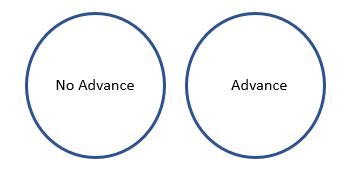The static transformation is the transformation of coordinates and time representing a test particle in space that is stationary (static). Since Einstein’s SR introduces the concept of relative velocity, the definition of static as used for a transformation is the transformation of coordinates and time for a test particle that is stationary relative to a non-moving observer in \(\mathcal{E}\) space. As a consequence of a stationary test particle, the local effect due to acceleration is zero. Therefore, the transformation is reduced to only the potential part.
\begin{equation}
\phi = \left(1 + \frac{G M}{r c^2}\right)^{-1}
\end{equation}
Thus, a vector’s components in \(\mathcal{P}\) space transforms to \(\mathcal{E}\) space via:
\begin{equation}
\vec{X_{\mathcal{E}}}=\phi \vec{X_{\mathcal{P}}}=\left(1 + \frac{G M}{r c^2}\right)^{-1}\vec{X_{\mathcal{P}}}
\end{equation}
Time transforms in the same manner:
\begin{equation}
t_{\mathcal{E}}=\phi t_{\mathcal{P}}=\left(1 + \frac{G M}{r c^2}\right)^{-1}t_{\mathcal{P}}
\end{equation}
The time interval (for example, a second) increases as \(r\rightarrow 0\). One unit of time in \(\mathcal{P}\) space is observed as “longer” than one unit of time in \(\mathcal{E}\) space, observed as the clock running slower.
Another observation is when the distance \(r\) is transformed from \(\mathcal{P}\) to \(\mathcal{E}\), an invariant length independent of \(r\) arises.
\begin{equation}
r_{\mathcal{E}} = \left(1 + \frac{G M}{r_{\mathcal{P}} c^2}\right)^{-1}r_{\mathcal{P}}= \frac{r_{\mathcal{P}}}{1+\frac{G M}{c^2}}
\end{equation}
Reversing it is:
\begin{equation}
r_{\mathcal{P}} = \left(1 + \frac{G M}{r_{\mathcal{P}} c^2}\right)r_{\mathcal{E}}= r_{\mathcal{E}} +\frac{G M}{c^2}
\end{equation}
One immediate consequence of this is when \(r_{\mathcal{E}}\) equals zero, \(r_{\mathcal{P}}\) does not equal zero. Instead, it is observed from \(\mathcal{P}\) as \(\frac{G M}{c^2}\). A second observance is an invariant length observed as added to all \(\mathcal{P}\) sphere’s radial distance \(r\). This invariant length added to all radial distances as observed from \(\mathcal{P}\) as added length or a negative length observed \(\mathcal{E}\) is the reason a Lorentzian manifold is not an appropriate description for the concentric spheres and tangent spaces, as shown. The Lorentzian manifold is constructed over a minimum twice differentiable (\(C^2\)) space. As a consequence of the added length, the space is no longer differentiable between spherical surfaces or tangential spaces. For convenience, the characteristic length \(\frac{G M}{c^2}\) will be termed \(L_c\). Although this value was discussed in the book Gravitation and derived from GR it is not applied nor derived in the same manner as in the NUVO theory.
Revisiting a central potential force that varies as \(\frac{1}{r}\), the change in the potential in a continuous space (like Lorentzian) will take the form of:
\begin{equation}\label{eqPotentialDifference}
\Delta E = \left(\frac{1}{r_{initial}} -\frac{1}{r_{initial}}\right)E_{potential}
\end{equation}
But in this theory’s transformation there is a difference between the observed and the actual radial distance (as previously discussed). The observed change in potential energy is:
\begin{equation}
\Delta E = \left(\frac{1}{r_{initial}+L_c} -\frac{1}{r_{initial}+r_c}\right)E_{potential}
\end{equation}
There is a shift in the observance. The \(L_c\) in the transformation has the same effect when transforming a static circle.
\begin{equation}
2 \pi r_{\mathcal{E}} =2 \pi (r_{\mathcal{E}} + L_c)
\end{equation}
Thus, an additional arc length is observed in a circular trajectory. In theory, this is not observable in a circular orbit because the orbit’s extra arc length overlaps the same arc of the circle, thus making it unobservable. Consider the trivial Figure below, one transformation has an advance; the other doesn’t. Yes, it is laughable, silly and thus trivial, but the point is an observer cannot distinguish between a circular orbit transformed with an advance and one transformed without an advance. In an elliptical orbit, this is not the case; an advance can be observed. This will play a role in volume 2 when looking at NUVO in the quantum realm.

The length \(L_c\) in a static transformation corresponds to the shifted value.